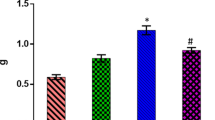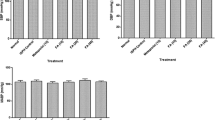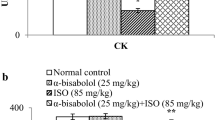Abstract
Apigenin (AP) is a flavone in dietary flavonoids reported as strong antioxidant and elite modulator of PPARγ. The current study evaluated the consequence of AP in isoproterenol (ISO)-induced oxidative stress and myocardial infarction during β-adrenergic receptor stimulus in rats by persistent hemodynamic, biochemical and histopathological changes. Rats received AP (25, 50 and 75 mg/kg/day) or vehicle i.p. for 14 days and ISO (100 mg/kg, s.c.) on 13th and 14th days for initiation of cardiotoxicity. ISO-treated rats showed evidence of significant dwindle in systolic and diastolic arterial pressures, maximal positive rate of developed left ventricular pressure. In totting up, a noteworthy diminution in activities of creatine kinase-MB isoenzyme, reduced glutathione, superoxide dismutase, catalase and level along with rise in malondialdehyde content were observed. The shielding function of AP on isoproterenol-induced myocardial damage was observed by attenuating all the endogenous parameters and the membrane-bound enzymes. It was confirmed by histopathological examinations. The effect of AP at the doses of 50 and 75 mg/kg showed added apparent than at the dose of 25 mg/kg. Current study thus provides confirmation for protective effects of AP on myocardium in experimentally induced myocardial infarction.






Similar content being viewed by others

References
Mei, Y., Thompson, M. D., & Cohen, R. A. (2015). Autophagy and oxidative stress in cardiovascular diseases. Biochimica et Biophysica Acta, 1852(2), 243–251.
Zheng, W., Antonini, J. M., Lin, Y. C., et al. (2015). Cardiovascular effects in rats after intratracheal instillation of metal welding particles. Inhalational Toxicology, 27(1), 45–53.
Adaramoye, O. A., & Lawal, S. O. (2015). Kolaviron, a biflavonoid fraction from Garcinia kola, protects against isoproterenol-induced injury by mitigating cardiac dysfunction and oxidative stress in rats. Journal of Basic and Clinical Physiology and Pharmacology, 26(1), 65–72.
Caldas, F. R. L., Leite, I. M. R., Filgueiras, A. B. T., de Figueiredo Júnior, I. L., de Sousa, T. A. G. M., Martins, P. R., & Facundo, H. D. T. F. (2015). Mitochondrial ATP-sensitive potassium channel opening inhibits isoproterenol-induced cardiac hypertrophy by preventing oxidative damage. Journal of Cardiovascular Pharmacology, 65(4), 393–397.
Christiansen, L. B., Dela, F., Koch, J., Hansen, C. N., Leifsson, P. S., & Yokota, T. (2015). Impaired cardiac mitochondrial oxidative phosphorylation and enhanced mitochondrial oxidative stress in feline hypertrophic cardiomyopathy. American Journal of Physiology-Heart and Circulatory Physiology, 308(10), H1237–H1247.
Guo, Z., Kozlov, S., Lavin, M. F., Person, M. D., & Paull, T. T. (2010). ATM activation by oxidative stress. Science, 330(6003), 517–521.
Goyal, S., Bharti, S., Sahoo, K. C., Sharma, A. K., & Arya, D. S. (2011). Valsartan, an angiotensin II receptor blocker, attenuates cardiac dysfunction and oxidative stress in isoproterenol-induced cardiotoxicity. Cardiovascular Toxicology, 11(2), 148–156.
Zeng, P., Liu, B., Wang, Q., Fan, Q., Diao, J. X., Tang, J., et al. (2015). Apigenin attenuates atherogenesis through inducing macrophage apoptosis via inhibition of AKT Ser473 phosphorylation and downregulation of plasminogen activator inhibitor-2. Oxidative Medicine and Cellular Longevity, 2015, 1–12.
Hirsh, J., Fuster, V., Ansell, J., & Halperin, J. L. (2003). American Heart Association/American College of Cardiology Foundation guide to warfarin therapy1. Journal of the American College of Cardiology, 41(9), 1633–1652.
Rona, G. (1985). Catecholamine cardiotoxicity. Journal of Molecular and Cellular Cardiology, 17(4), 291–306.
Mukherjee, D., Ghosh, A. K., Dutta, M., Mitra, E., Mallick, S., Saha, B., & Bandyopadhyay, D. (2015). Mechanisms of isoproterenol-induced cardiac mitochondrial damage: protective actions of melatonin. Journal of Pineal Research, 58(3), 275–290.
Vazan, R., & Ravingerova, T. (2015). Protective effect of melatonin against myocardial injury induced by epinephrine. Journal of Physiology and Biochemistry, 71(1), 43–49.
Ojha, S., Azimullah, S., Mohanraj, R., Sharma, C., Yasin, J., Arya, D. S., & Adem, A. (2015). Thymoquinone protects against myocardial ischemic injury by mitigating oxidative stress and inflammation. Evidence-Based Complementary and Alternative Medicine, 501, 629–636.
Zhou, R., Xu, Q., Zheng, P., Yan, L., Zheng, J., & Dai, G. (2008). Cardioprotective effect of fluvastatin on isoproterenol-induced myocardial infarction in rat. European Journal of Pharmacology, 586(1), 244–250.
Zhu, L., Wei, T., Chang, X., He, H., Gao, J., Wen, Z., et al. (2015). Effects of salidroside on myocardial Injury in vivo in vitro via Regulation of Nox/NF-κB/AP1 Pathway. Inflammation, 38(4), 1589–1598.
Rani, N., Bharti, S., Bhatia, J., Tomar, A., Nag, T. C., Ray, R., & Arya, D. S. (2015). Inhibition of TGF-β by a novel PPAR-γ agonist, chrysin, salvages β-receptor stimulated myocardial injury in rats through MAPKs-dependent mechanism. Nutrition and Metabolism, 12(1), 11.
Chen, K., & Keaney, J. F. (2012). Evolving concepts of oxidative stress and reactive oxygen species in cardiovascular disease. Current Atherosclerosis Reports, 14, 476–483.
Dianita, R., Jantan, I., Amran, A. Z., & Jalil, J. (2015). Protective Effects of Labisia pumila var. alata on biochemical and histopathological alterations of cardiac muscle cells in isoproterenol-induced myocardial infarction rats. Molecules, 20(3), 4746–4763.
Mnafgui, K., Hajji, R., Derbali, F., Khlif, I., Kraiem, F., Ellefi, H., et al. (2015). Protective effect of hydroxytyrosol against cardiac remodeling after isoproterenol-induced myocardial infarction in rat. Cardiovascular Toxicology. doi:10.1007/s12012-015-9323-1.
Mahmood, T., Siddiqui, H. H., Dixit, R., Bagga, P., & Hussain, S. (2015). Protective effect of Bombyx mori l cocoon (abresham) and its formulations against isoproterenol-induced cardiac damage. Tropical Journal of Pharmaceutical Research, 14(1), 63–72.
Panda, S. (2015). Butanolic fraction of Moringa oleifera Lam.(Moringaceae) attenuates isoprotrenol–induced cardiac necrosis and oxidative stress in rats. EXCLI Journal, 14, 64–74.
Devika, P. T., & Prince, P. S. M. (2008). Protective effect of (−)-epigallocatechin-gallate (EGCG) on lipid peroxide metabolism in isoproterenol induced myocardial infarction in male Wistar rats: A histopathological study. Biomedicine and Pharmacotherapy, 62(10), 701–708.
Arango, D., Morohashi, K., Yilmaz, A., Kuramochi, K., Parihar, A., Brahimaj, B., et al. (2013). Molecular basis for the action of a dietary flavonoid revealed by the comprehensive identification of apigenin human targets. Proceedings of the National Academy of Sciences, 110(24), E2153–E2162.
Manach, C., Scalbert, A., Morand, C., Remesy, C., & Jimenez, L. (2004). Polyphenols: food sources and bioavailability. American Journal of Clinical Nutrition, 79, 727–747.
Clere, N., Faure, S., Carmen Martinez, M., & Andriantsitohaina, R. (2011). Anticancer properties of flavonoids: roles in various stages of carcinogenesis. Cardiovascular & Hematological Agents in Medicinal Chemistry (Formerly Current Medicinal Chemistry-Cardiovascular & Hematological Agents), 9(2), 62–77.
Wei, H., Tye, L., Bresnick, E., & Birt, D. F. (1990). Inhibitory effect of apigenin, a plant flavonoid, on epidermal ornithine decarboxylase and skin tumor promotion in mice. Cancer Research, 50(3), 499–502.
Shukla, S., & Gupta, S. (2010). Apigenin: a promising molecule for cancer prevention. Pharmaceutical Research, 27(6), 962–978.
Mascaraque, C., Gonzalez, R., Suárez, M. D., Zarzuelo, A., Sanchez de Medina, F., & Martinez-Augustin, O. (2015). Intestinal anti-inflammatory activity of apigenin K in two rat colitis models induced by trinitrobenzenesulfonic acid and dextran sulphate sodium. British Journal of Nutrition, 113(04), 618–626.
Li, R. J., He, K. L., Li, X., Wang, L. L., Liu, C. L., & He, Y. Y. (2015). Salubrinal protects cardiomyocytes against apoptosis in a rat myocardial infarction model via suppressing the dephosphorylation of eukaryotic translation initiation factor 2α. Molecular Medicine Reports, 12(1), 1043–1049.
Wright, J. P. E., Spencer, J. A., & Lovegrove, J. M. (2013). Flavonoid inhibitory pharmacodynamics on platelet function in physiological environments. Food and Function, 4, 1803–1810.
Chunhua, L., Xiuqiong, L., Donglan, F., et al. (2013). Apigenin upregulates transgelin and inhibits invasion and migration of colorectal cancer through decreased phosphorylation of AKT. Journal of Nutritional Biochemistry, 24, 1766–1775.
Chen, S., Zheng, S., Liu, Z., Tang, C., Zhao, B., Du, J., et al. (2015). Endogenous sulfur dioxide protects against oleic acid-induced acute lung injury in association with inhibition of oxidative stress in rats. Laboratory Investigation, 95, 142–156.
Touyz, R. M., & Briones, A. M. (2011). Reactive oxygen species and vascular biology: Implications in human hypertension. Hypertension Research, 34, 5–14.
Armitage, M. E., La, M., Schmidt, H. H. W., et al. (2010). Diagnosis and individual treatment of cardiovascular diseases: Targeting vascular oxidative stress. Expert in Review of Clinical Pharmacology, 3, 639–648.
Vilela, D., Castañeda, R., González, M. C., Mendoza, S., & Escarpa, A. (2015). Fast and reliable determination of antioxidant capacity based on the formation of gold nanoparticles. Microchimica Acta, 182(1–2), 105–111.
Agatonovic-Kustrin, S., Ortakand, D. B., Morton, D. W., & Yusof, A. P. (2015). Rapid evaluation and comparison of natural products and antioxidant activity in calendula, feverfew, and German chamomile extracts. Journal of Chromatography A, 1385, 103–110.
Desoky, N., El-Bassossy, H. M., Fahmy, A., & Azhar, A. (2015). Apigenin restores normal vascular reactivity in diabetic rats via protein kinase C inhibition. Zagazig University Medical Journal, 20(1), 20–29.
Park, M. H., & Kim, J. G. (2015). Low-dose UV-C irradiation reduces the microbial population and preserves antioxidant levels in peeled garlic (Allium sativum L.) during storage. Postharvest Biology and Technology, 100, 109–112.
Monsalve, F. A., Pyarasani, R. D., Delgado-Lopez, F., & Moore-Carrasco, R. (2013). Peroxisome proliferator-activated receptor targets for the treatment of metabolic diseases. Mediators of Inflammation, 2013, 1–18.
Liang, Yu-Chih, Shu-Huei, Tsai, De-Cheng, Tsai, Shoei-Yn, Lin-Shiau, & Jen-Kun, Lin. (2001). Suppression of inducible cyclooxygenase and nitric oxide synthase through activation of peroxisome proliferator-activated receptor-γ by flavonoids in mouse macrophages. FEBS Letters, 496(1), 12–18.
Kim, J. H., Song, J., Park, K. W. (2015). The multifaceted factor peroxisome proliferator-activated receptor γ (PPARγ) in metabolism, immunity, and cancer.Archives of Pharmacal Research, 38(3), 302–312.
Garretson, J. T., Teubner, B. J., Grove, K. L., Vazdarjanova, A., Ryu, V., & Bartness, T. J. (2015). Peroxisome proliferator-activated receptor γ controls ingestive behavior, agouti-related protein, and neuropeptide Y mRNA in the arcuate hypothalamus. The Journal of Neuroscience, 35(11), 4571–4581.
Rangwala, S. M., & Lazar, M. A. (2004). Peroxisome proliferator-activated receptor γ in diabetes and metabolism. Trends in Pharmacological Sciences, 25(6), 331–336.
Kim, M. A., Kang, K., Lee, H. J., Kim, M., Kim, C. Y., & Nho, C. W. (2014). Apigenin isolated from Daphne genkwa Siebold et Zucc. Inhibits 3T3-L1 preadipocyte differentiation through a modulation of mitotic clonal expansion. Life Sciences, 101(1), 64–72.
Musa, H. H., Ahmed, A. A., Musa, T. H., & Fedail, J. S. (2015). Gum arabic down-regulate PPAR-γ and SCD mRNA expression in mice. Polish Annals of Medicine, 22(1), 11–17.
Liang, Y. C., Tsai, S. H., Tsai, D. C., Lin-Shiau, S. Y., & Lin, J. K. (2001). Suppression of inducible cyclooxygenase and nitric oxide synthase through activation of peroxisome proliferator-activated receptor-γ by flavonoids in mouse macrophages. FEBS Letters, 496(1), 12–18.
Aswar, U., Mahajan, U., Nerurkar, G., & Aswar, M. (2013). Amelioration of cardiac hypertrophy induced by abdominal aortic banding in ferulic acid treated rats. Biomedicine & Aging Pathology, 3(4), 209–217.
Ojha, S. K., Nandave, M., Arora, S., Narang, R., Dinda, A. K., & Arya, D. S. (2008). Chronic administration of Tribulus terrestris Linn extract improves cardiac function and attenuates myocardial infarction in rats. International Journal of Pharmacology, 4, 1–10.
Maron, M. S., Depierre, J. W., & Manmerik, B. (1979). Level of glutathione, glutathione reductase and glutathione-S-transferase activity in rat lung and liver. Biochimica Biophysica Acta, 82, 67–78.
Ohkawa, H., Ohishi, N., & Yagi, K. (1979). Assay of lipid peroxide in animal tissue by thiobarbituric acid reaction. Annuls of Biochemistry, 95, 351–358.
Aebi, H. (1974). Catalase. In H. E. Bergameyer (Ed.), Methods of enzymatic analysis (pp. 673–685). New York: Academic Press Inc.
Misra, H. P., & Fridovich, I. (1978). Inhibition of superoxide dismutases by azide. Archives of Biochemistry and Biophysics, 189(2), 317–322.
Lamprecht, W., Stan, F., Weisser, H., & Heinz, F. (1974). Determination of creatine phosphate and adenosine triphosphate with creatine kinase. In H. U. Bergmeyer (Ed.), Methods of enzymatic analysis (pp. 1776–1778). New York: Academic Press.
Cabaud, P., & Wroblewski, G. (1958). Calorimetric measurements of lactic dehydrogenase activity of body fluids. American Journal of Clinical Pathology, 3, 234–236.
Hassan, M. Q., Akhtar, M. S., Akhtar, M., Ali, J., Haque, S. E., Najmi, A. K. (2015). Edaravone protects rats against oxidative stress and apoptosis in experimentally induced myocardial infarction: Biochemical and Ultrastructural Evidences. Redox Report. doi:10.1179/1351000215Y.0000000011.
Dianita, R., Jantan, I., Amran, A. Z., & Jalil, J. (2015). Protective effects of Labisia pumila var. alata on biochemical and histopathological alterations of cardiac muscle cells in isoproterenol-induced myocardial infarction rats. Molecules, 20(3), 4746–4763.
Taghavi, S., Sharp, T. E., Duran, J. M., Makarewich, C. A., Berretta, R. M., Starosta, T., Houser, S. R. (2015). Autologous c‐Kit + mesenchymal stem cell injections provide superior therapeutic benefit as compared to c‐Kit + cardiac‐derived stem cells in a feline model of isoproterenol‐induced cardiomyopathy. Clinical and Translational Science, 1–8.
Carll, A. P., Haykal-Coates, N., Winsett, D. W., Hazari, M. S., Ledbetter, A. D., Richards, J. H., & Farraj, A. K. (2015). Cardiomyopathy confers susceptibility to particulate matter-induced oxidative stress, vagal dominance, arrhythmia and pulmonary inflammation in heart failure-prone rats. Inhalation Toxicology, 27(2), 100–112.
Chang, C. Y., Lin, T. Y., Lu, C. W., Wang, C. C., Wang, Y. C., Chou, S. S. P., et al. (2015). Apigenin, a natural flavonoid, inhibits glutamate release in the rat hippocampus. European Journal of Pharmacology, 762, 72–81.
Mnafgui, K., Hajji, R., Derbali, F., Khlif, I., Kraiem, F., Ellefi, H., et al. (2015). Protective effect of hydroxytyrosol against cardiac remodeling after isoproterenol-induced myocardial infarction in rat. Cardiovascular Toxicology. doi:10.1007/s12012-015-9323-1.
Goyal, S. N., Bharti, S., Bhatia, J., Nag, T. C., Ray, R., & Arya, D. S. (2011). Telmisartan, a dual ARB/partial PPAR-γ agonist, protects myocardium from ischaemic reperfusion injury in experimental diabetes. Diabetes, Obesity and Metabolism, 13(6), 533–541.
Testai, L., Martelli, A., Cristofaro, M., Breschi, M. C., & Calderone, V. (2013). Cardioprotective effects of different flavonoids against myocardial ischaemia/reperfusion injury in Langendorff-perfused rat hearts. Journal of Pharmacy and Pharmacology, 65(5), 750–756.
Hu, J., Li, Z., Xu, L. T., Sun, A. J., Fu, X. Y., Zhang, L., et al. (2014). Protective effect of apigenin on ischemia/reperfusion injury of the isolated rat heart. Cardiovascular toxicology, 15(3), 241–249.
Verbeek, R., Plomp, A. C., van Tol, E. A., & van Noort, J. M. (2004). The flavones luteolin and apigenin inhibit in vitro antigen-specific proliferation and interferon-gamma production by murine and human autoimmune T cells. Biochemical Pharmacology, 68(4), 621–629.
Huk, I., Brovkovych, V., Nanobash, V. J., Weigel, G., Neumayer, C., & Partyka, L. (1998). Bioflavonoid quercetin scavenges superoxide and increases nitric oxide concentration in ischaemia-reperfusion injury: an experimental study. British Journal of Surgery, 85, 1080–1085.
Wang, C. N., Chi, C. W., Lin, Y. L., Chen, C. F., & Shiao, Y. J. (2001). The neuroprotective effects of phytoestrogens on amyloid beta protein-induced toxicity are mediated by abrogating the activation of caspase cascade in rat cortical neurons. Journal of Biology and Chemistry, 276, 5287–5295.
Jin, B. H., Qian, L. B., Chen, S., Li, J., Wang, H. P., & Bruce, I. C. (2009). Apigenin protects endothelium-dependent relaxation of rat aorta against oxidative stress. European Journal of Pharmacology, 616, 200–205.
Yamagata, K., Tagawa, C., Matsufuji, H., & Chino, M. (2012). Dietary apigenin regulates high glucose and hypoxic reoxygenation-induced reductions in apelin expression in human endothelial cells. Journal of Nutritional Biochemistry, 23, 929–936.
Ito, H., Nakano, A., Kinoshita, M., & Matsumori, A. (2003). Pioglitazone, a peroxisome proliferator-activated receptor-gamma agonist, attenuates myocardial ischemia/reperfusion injury in a rat model. Laboratory Investigation, 83, 1715–1721.
Yue, T. L., Chen, J., Bao, W., Narayanan, P. K., Bril, A., Jiang, W., et al. (2001). In vivo myocardial protection from ischemia/reperfusion injury by the peroxisome proliferator-activated receptor-gamma agonist rosiglitazone. Circulation, 104, 2588–2594.
Yuan, Z., Liu, Y., Liu, Y., Zhang, J., Kishimoto, C., Wang, Y., et al. (2003). Peroxisome proliferation-activated receptor-gamma ligands ameliorate experimental autoimmune myocarditis. Cardiovascular Research, 59, 685–694.
Sakai, S., Miyauchi, T., Irukayama-Tomobe, Y., Ogata, T., Goto, K., & Yamaguchi, I. (2002). Peroxisome proliferator-activated receptor-gamma activators inhibit endothelin-1-related cardiac hypertrophy in rats. Clinical Science, 103, 16S–20S.
Zhang, T., Yan, T., Du, J., Wang, S., & Yang, H. (2015). Apigenin attenuates heart injury in lipopolysaccharide-induced endotoxemic model by suppressing sphingosine kinase 1/sphingosine 1-phosphate signaling pathway. Chemico-Biological Interactions, 233, 46–55.
Tocchetti, C. G., Leppo, M., Wang, Y., Weiss, R. G., & Paolocci, N. (2015). Cardiac over-expression of creatine kinase improves function in failing myocytes. Biophysical Journal, 108(2), 595a–600a.
Li, R., Zhao, D., Qu, R., Fu, Q., & Ma, S. (2015). The effects of apigenin on lipopolysaccharide-induced depressive-like behavior in mice. Neuroscience Letters, 594, 17–22.
Golikov, P. A., Polumiskov, V. I. V., Davydov, B. V., Karev, V. A., Bashkatov, V. G., Belezerov, G. E., et al. (1989). Lipid peroxidation and the major factor of its activation in patients with myocardial infarction. Kardiologiia, 29, 53–59.
Halliwell, B., & Chirico, S. (1993). Lipid peroxidation: its mechanism, measurement, and significance. The American Journal of Clinical Nutrition, 57(5), 715S–724S.
Meeran, M. F. N., Jagadeesh, G. S., & Selvaraj, P. (2015). Thymol attenuates inflammation in isoproterenol induced myocardial infarcted rats by inhibiting the release of lysosomal enzymes and downregulating the expressions of proinflammatory cytokines. European Journal of Pharmacology, 754, 153–161.
Rajadurai, M., & Prince, P. S. M. (2006). Preventive effect of naringin on lipid peroxides and antioxidants in isoproterenol-induced cardiotoxicity in Wistar rats: biochemical and histopathological evidences. Toxicology, 228(2), 259–268.
Atoui, A. K., Mansouri, A., Boskou, G., & Kefalas, P. (2005). Tea and herbal infusions: their antioxidant activity and phenolic profile. Food Chemistry, 89(1), 27–36.
Acknowledgments
The authors gratefully acknowledge the financial support received under Young Scientist Research Scheme (File no. SB/YS/LS-114/2013) of Science and Engineering Research Board (SERB), Department of Science and Technology, New Delhi, India.
Author information
Authors and Affiliations
Corresponding author
Ethics declarations
Conflict of interest
The author(s) confirm that this article content has no conflict of interest.
Rights and permissions
About this article
Cite this article
Buwa, C.C., Mahajan, U.B., Patil, C.R. et al. Apigenin Attenuates β-Receptor-Stimulated Myocardial Injury Via Safeguarding Cardiac Functions and Escalation of Antioxidant Defence System. Cardiovasc Toxicol 16, 286–297 (2016). https://doi.org/10.1007/s12012-015-9336-9
Published:
Issue Date:
DOI: https://doi.org/10.1007/s12012-015-9336-9



